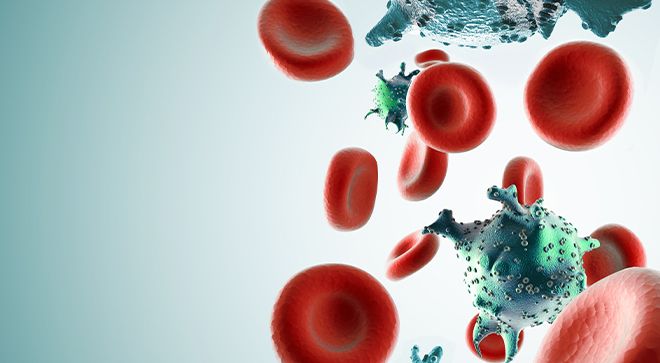Article
Novel Combination Therapy Contributes to Additional Progression-Free Survival Benefit Compared With Chemoimmunotherapy in Patients with CLL
Author(s):
The combination of ublituximab and umbralisib, two novel compounds, was able to safely prolong progression-free survival with low rates of toxicities in patients with chronic lymphocytic leukemia compared with standard of care chemoimmunotherapy regardless of prior treatment.
The combination of ublituximab and umbralisib, two novel compounds, has shown synergistic activity in patients with chronic lymphocytic leukemia (CLL) compared with chemoimmunotherapy, the standard of care, regardless of prior treatment.
Results from the phase 3 UNITY-CLL study were presented at the 2020 ASH Meeting.
“Bruton tyrosine kinase and BCL-2 [B-cell lymphoma] inhibitors have dramatically changed the therapeutic landscape of CLL, but not all patients are candidates for these agents and mechanisms of resistance have already been identified,” said global study chair, Dr. John G. Gribben, professor of experimental cancer medicine, director of both the Experimental Cancer Medicine Centre and Stem Cell Transplantation at Saint Bartholomew’s Hospital at Queen Mary’s School of Medicine at the University of London, during a virtual presentation of the data.
“I think PI3Kδ inhibitors offer a distinct mechanism of action from all the Bruton tyrosine kinase and BCL-2 inhibitors and have demonstrated promising activity in the relapsed/refractory CLL setting.”
At a median follow-up of 36.7 months, ublituximab and umbralisib significantly prolonged progression-free survival (PFS) compared with Gazyva (obinutuzumab) plus Leukeran (chlorambucil) across subgroups. The median PFS was 31.9 months in patients assigned ublituximab and umbralisib versus 17.9 months with the Gazyva combination. In addition, 24-month PFS rates were 60.8% and 40.4%, respectively.
In patients who had no prior treatment at time of enrollment, the median PFS was 38.5 months with ublituximab and umbralisib compared with 26.1 months with the Gazyva combination. The 24-month PFS rates were 76.6% and 52.1%, respectively.
For the subgroup of patients who received a median of two prior therapies, those randomized to the ublituximab and umbralisib cohort also had a PFS benefit with ublituximab and umbralisib (19.5 months) compared with Gazyva plus Leukeran (12.9 months).
In addition to its efficacy, the ublituximab and umbralisib regimen has a favorable safety profile and exhibited low rates of immune-mediated side effects that are typically associated with other drugs of this kind including diarrhea, colitis (inflammation of the colon’s inner lining), pneumonia, and hepatic ( liver) toxicity. In previously untreated patients, these toxicities lead to discontinuation rates of over 50%.
In total, 421 patients with treatment-naïve or relapsed/refractory CLL were included in the primary analysis of the UNITY-CLL trial; 57% of patients were treatment-naïve and 43% had relapsed/refractory CLL.
Umbralisib was given orally at 800 mg once-daily until progression or treatment discontinuation. Ublituximab was administered intravenously at 900 mg on days one and two (150 mg on day one followed by 750 mg on day two), eight and 15 of cycle one; day one of cycles two to six, and on day one every three cycles after cycle six. Gazyva was given intravenously at 1000 mg on days one and two (100 mg on day one followed by 900 mg on day two), eight and 15 of cycle one; day one of cycles two to six. Leukeran was given orally at 0.5 mg/kg on day one and 15 of cycles one to six. Each cycle was 28 days.
The primary end point was independent review committee-assessed PFS, and key secondary end points included independent review committee-assessed overall response rate (ORR), complete response (CR) and safety assessed from the first dose until 30 days after the last dose.
The ORR for 210 patients treated in the ublituximab and umbralisib cohort was 83.3% compared with 68.7% for the 211 patients in the Gazyva arm. Of the responders, 5% achieved a CR or CR with incomplete marrow recovery, and 79% had a partial response with ublituximab and umbralisib, compared with 1% with CR or CR with incomplete marrow recovery and 67% with partial response with Gazyva.
ORRs were 84%, 82% and 57% for patients in the ublituximab and umbralisib cohort who were treatment naïve, were previously treated and those who had prior treatment with a Bruton tyrosine kinase inhibitor, respectively. The ORRs were 78%, 57% and 25% for those treated with Gazyva.
“Responses (observed) with (ublituximab and umbralisib) were durable, with 62% of patients maintaining response at two years and a 93% disease control rate was achieved using the (ublituximab and umbralisib) regimen,” said Gribben. The median treatment exposure for ublituximab and umbralisib was 21 months compared with 5 months for Gazyva and chlorambucil, Gribben added. At the time of follow-up, treatment was ongoing for 77 patients (37%) with ublituximab and umbralisib.
In a review of the safety analysis, Gribben noted that continuous treatment with ublituximab and umbralisib resulted in over four-fold longer exposure and reporting period for the regimen compared with Gazyva and chlorambucil. Grade 3/4 adverse events of clinical interest for ublituximab and umbralisib versus the chemoimmunotherapy regimen included elevated alanine aminotransferase (an enzyme in the liver and kidney; 8.3% vs 1.0%), elevated aspartate aminotransferase (an enzyme in cells found in the liver, heart, muscles and kidneys; 5.3% vs 2.0%), noninfectious colitis (1.9% vs 0%), infectious colitis (0.5% vs 0.5%), pneumonitis (lung tissue inflammation; 0.5% vs 0%), rash (2.4% vs 0.5%) and opportunistic infections (frequently occurring infections; 5.8% vs 1.5%). Adverse events led to treatment discontinuation in 35 patients (17%) assigned ublituximab and umbralisib and 16 patients (8%) assigned Gazyva and chlorambucil.
“Focusing in on those grade 3 and 4 adverse events and looking at the treatment-naïve versus patients who were previously treated, diarrhea occurred slightly more frequently in the treatment-naïve patient population [13.8% vs 10.0%], but neutropenia was more common in those patients who were previously treated [24.1% vs 40.0%]. Other adverse events were relatively rare,” Gribben said.
A version of this article originally appeared on OncLive® as, “Ublituximab/Umbralisib Outperforms Chemoimmunotherapy in Patients with CLL.”
For more news on cancer updates, research and education, don’t forget to subscribe to CURE®’s newsletters here.





